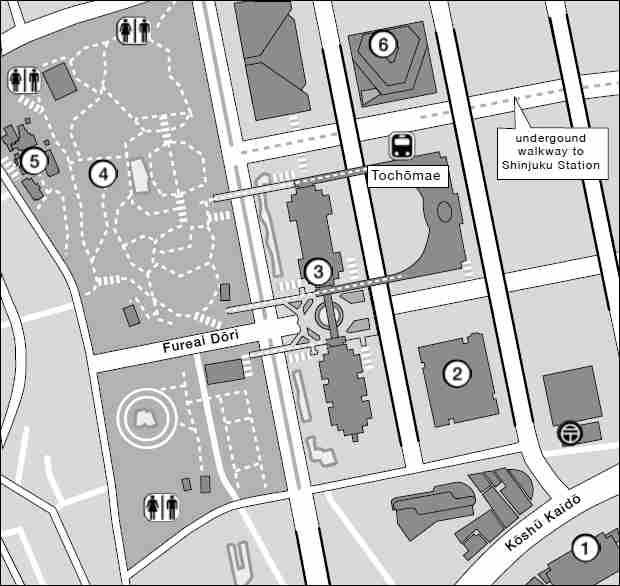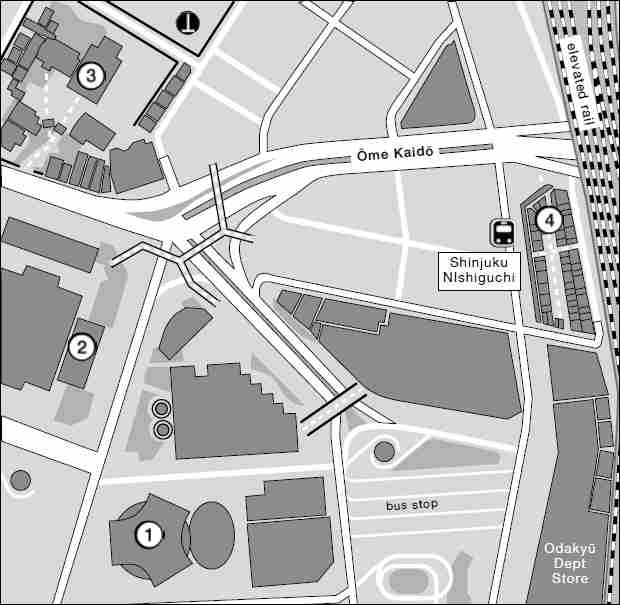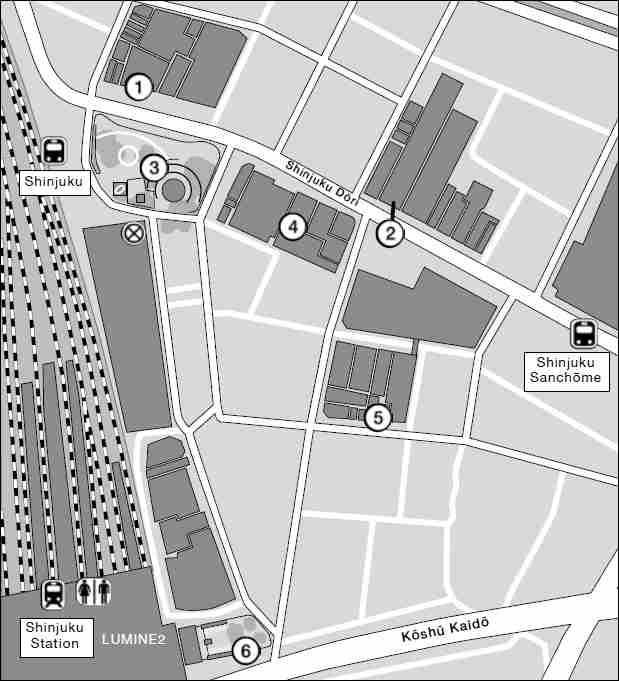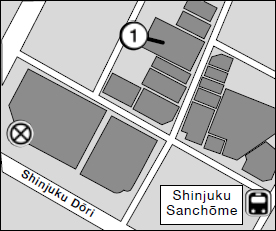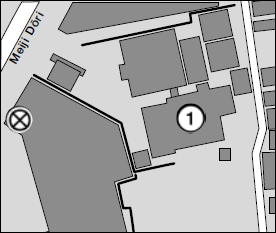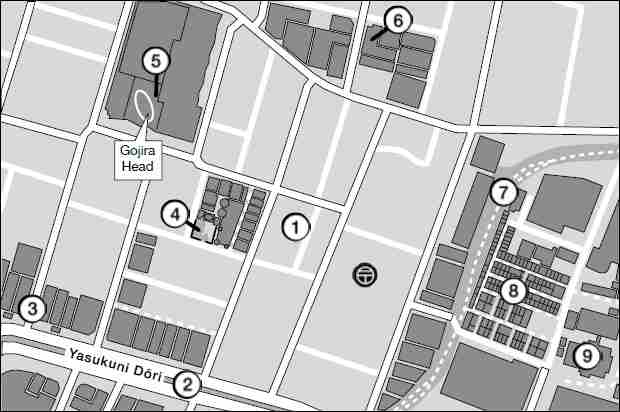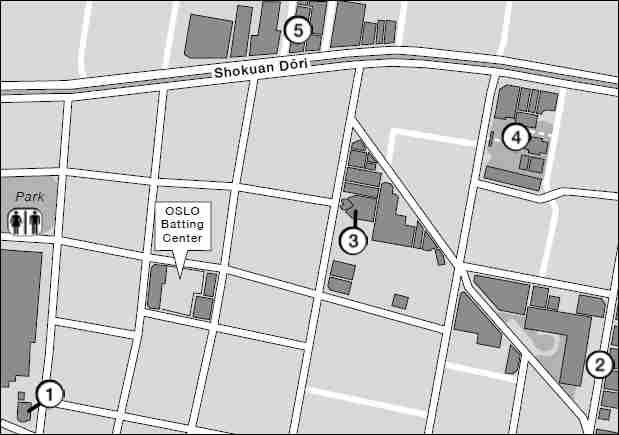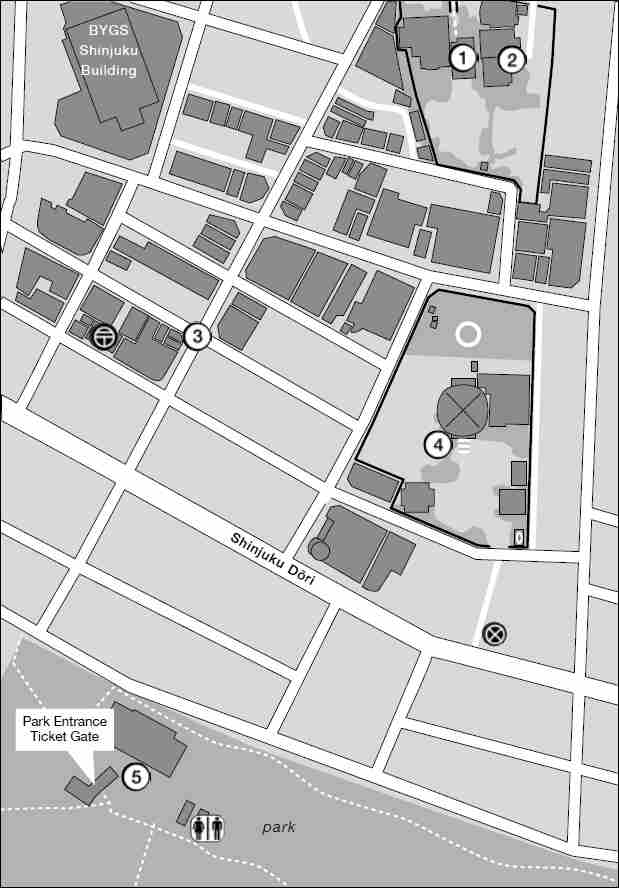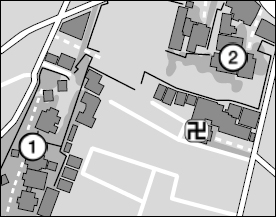新宿駅
SHINJUKU STATION AREA
The Shinjuku Station area has two sides—literally. Well, also metaphorically, as you will come to see as you wander in the area. The massive Shinjuku Station complex, which gets about 3.5 million travelers a day, divides east and west. The tracks of the JR Yamanote Line run through the neighborhood from north to south, adding to the division. Both sides have modern buildings, interspersed with temples and shrines. One colorful aspect of the neighborhood is the Shinjuku Tiger, who has been dressing up and wearing a tiger mask for more than forty-five years. Perhaps you will see him delivering newspapers on his bike in the morning or evening. He is the subject of a documentary by Satō Yoshinori entitled Shinjuku Tiger.
All in all there is lots here, so pick your focus and perhaps divide this chapter into more than one visit.
Shinjuku West Side / Shinjuku Nishi 新宿西
The west side of Shinjuku Station has far fewer of the old temples, shrines, and businesses found in the east. Much of the area had been large a marshland until the Meiji period, until the Yodobashi Water Purification Plant, Japan’s first modern water plant, was built in 1898. The plant continued operation until 1968, at which time the land was marked for development and the building boom began. The west side of the station is filled mainly with department stores, modern hotels, skyscraper office towers, and the massive Tokyo Metropolitan Government complex. Don’t discount the area as not very good for strolling, as there are interesting sights scattered about.
SHINJUKU STATION AREA WEST
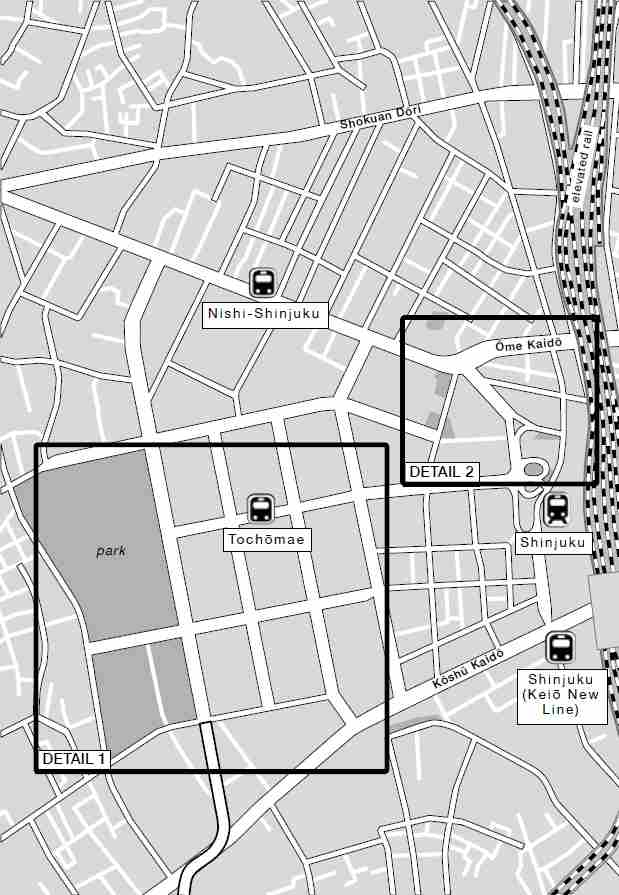
SHINJUKU STATION AREA EAST

Shinjuku East Side / Shinjuku Higashi 新宿東
There are so many entries for the east side that the latter portion of this chapter—detail maps 3 through 9—is devoted to it. This is the part of the Shinjuku Station area with the richest history. In the 17th century, a new rest station with inns and other businesses for travelers was established here on Kōshū Kaidō, one of the five major roadways of the Edo period. In time other businesses moved in. Eventually, the train station was built, and other train lines converged here, bringing a steady stream of passengers. More businesses followed, and the area developed into what it is today. The east side is where you will find many major department stores, numerous smaller businesses, restaurants, and a varied (but seedy at times) bar district.
DETAIL 1
 Bunka Gakuen Costume Museum / Bunka Gakuen Fukushoku Hakubutsukan 文化学園服飾博物館
Bunka Gakuen Costume Museum / Bunka Gakuen Fukushoku Hakubutsukan 文化学園服飾博物館
You won’t find cosplay on exhibit here: This is a museum focusing on normal apparel. The museum was established in 1979 and moved to the present location in 2003. The initial collection was composed of garments from the West, Japanese Western-style clothes, and kimono, which the school had started collected before the war. After World War II they began expanding by adding a collection gathered by an organization connected with the Japanese military. There are four thematic exhibits each year and the museum is closed when they are preparing them.
 https://museum.bunka.ac.jp/english/
https://museum.bunka.ac.jp/english/
This thirty-story building was designed by Nikken Sekkei and completed in 1982. The first through third floors house various commercial businesses. The top two floors are home to restaurants, with a sky bridge on the twenty-ninth floor. The remaining floors consist of offices. The roof is glass with lights for nighttime illumination. The most stunning aspect of the building is the atrium, which extends the full height of the structure. There is a huge water-powered clock in the atrium that spans several floors.
 http://www.shinjuku-ns.co.jp
http://www.shinjuku-ns.co.jp
 Tokyo Metropolitan Government Building / Tōkyō To Chōsha 東京都庁舎
Tokyo Metropolitan Government Building / Tōkyō To Chōsha 東京都庁舎
The Tokyo Metropolitan Government Offices are in three buildings. Security is tight in all three and many areas are not open to the public. The most famous of the three is the tallest, the twin-towered Office Building Number One, designed by Tange Kenzō and completed in 1991. The building also has two tourism information centers, one for Japan on the second floor and one for Tokyo on the first. You may want to visit them to pick up some useful fliers. The two towers are popular destinations for their views of the city as each have observation decks on the forty-fifth floor. Both also have souvenir shops and restaurants. Building Number Two is pretty much just offices. The Tokyo Metropolitan Assembly Building has a large plaza with statuary, which is a good place to take photographs of Building Number One.
 http://www.yokoso.metro.tokyo.jp/en/
http://www.yokoso.metro.tokyo.jp/en/
SHINJUKU STATION DETAIL 1
 Shinjuku Central Park / Shinjuku Chūō Kōen 新宿中央公園
Shinjuku Central Park / Shinjuku Chūō Kōen 新宿中央公園
This park was established in 1960 on a portion of the old Tokyo Yodobashi Purification Plant. The park includes hills, playgrounds, ponds, waterfalls, and fountains, and contains 80,000 trees. A portion of the land was once part of Jūnisō Kumano Jinja, so many of the trees are older than the park. This is a pleasant place to stroll and take a break. When I first visited the park many years ago, there was a small cluster of shelters built by local homeless in the corner closest to the local police station. Given the Japanese government’s ongoing efforts to reduce homelessness, such shelters are rarely seen today. An excellent view of the park from above can be had from the observation floors of the Tokyo Metropolitan Government Building.
The homeless main characters in Satoshi Kon’s excellent movie Tokyo Godfathers live in this park.
Kumano shrines are devoted to the three sacred mountains Hongū, Shingū, and Nachi. This Kumano shrine was established sometime in the Muromachi period. The buildings and grounds are impressive. One can also find interesting small sub-shrines and some large painted ema, with at least one dating from the 18th century. The local ponds and waterfalls were a popular viewing spot before they were eliminated in the Meiji period to create the modern waterworks. In his series Hundred Views of Edo Hiroshige included a print of a large pond with part of this shrine visible near the bottom.
You can get to the shrine from the road on the west side near the pedestrian overpass or through Shinjuku Central Park.
 Memorial Museum for Soldiers, Detainees in Siberia, and Postwar Repatriates / Heiwa Kinen Tenji Shiryōkan 平和祈念展示資料館
Memorial Museum for Soldiers, Detainees in Siberia, and Postwar Repatriates / Heiwa Kinen Tenji Shiryōkan 平和祈念展示資料館
This museum opened in 2000 and is sometimes referred to as the Peace Memorial Museum. It is devoted to the experiences at the end of World War II of those Japanese who were sent overseas as soldiers or settlers. Many were not able to evacuate as the war ended and were either imprisoned as POWs or stranded as foreign civilians. Many ended up in camps in Siberia where they suffered hardships. Others were separated from their families in the confusion at the end of the war. The voyage back to Japan is included in the exhibits, showing items people brought back with them and documents involved in the process of repatriation. The museum is located on the thirty-third floor of the Shinjuku Sumitomo Building.
 https://www.heiwakinen.go.jp/english-index/
https://www.heiwakinen.go.jp/english-index/
DETAIL 2
 MODE GAKUEN Cocoon Tower モード学園コクーンタワー
MODE GAKUEN Cocoon Tower モード学園コクーンタワー
Designed by Tange Associates and completed in 2008, this fifty-story building houses three schools, with a student body of roughly 10,000. The main school is MODE GAKUEN, which focuses on design, arts, and fashion. There are two other MODE GAKUEN campuses in Osaka and Nagoya, which also have very interesting buildings. The other two schools in this building are: HAL Tokyo, focusing on IT, music, computer graphics, and game design; and Shuto Ikō, a school devoted to training medical care staff. One interesting feature of this structure: Buildings beyond a certain height are required by law to have a helipad for emergencies. Here, the lack of a flat roof is dealt with by having the helipad folded up when not needed.
 https://www.mode.ac.jp/tokyo
https://www.mode.ac.jp/tokyo
NOTE: The school prefers people not sightsee in the building. Please enjoy the exterior.
A museum devoted to the paintings of Tōgō Seiji (1897–1978) and his contemporaries. Tōgō received many awards in his lifetime, including the Western Art Promotion Award in 1928 and the Japan Art Academy Award in 1957. He was made an Officier d’Ordre des Arts et des Lettres by the French government in 1969, and was awarded the Order of the Rising Sun, Second Class, with Rays in 1976. After his death, the Japanese government named him a Person of Cultural Merit of the fourth court rank. The museum was established in 1976 and is located on the forty-second floor of the Sompo Japan Nipponkoa headquarters building.
 https://www.sompo-museum.org/en/
https://www.sompo-museum.org/en/
The date of the origin of this Nichiren Buddhist temple is unknown, however it is known that the temple was moved to this location in 1585. The temple was damaged in the firebombings of World War II and the current main hall dates from 1964. One unusual feature of the temple is that the stone with the temple name is both in kanji and Roman letters. This temple has an extensive graveyard and a cherry tree that is one of the “Edo sanboku,” the three famous trees of Edo.
Access can be found on the south side.
The official name of this small group of shops translates as “Shinjuku Memory Lane.” This is the remains of a black market established around 1946. The area grew from a series of stalls selling all sorts of things including roasted meats—mainly offal, which was not rationed—obtained from US forces during the early postwar years. Several were owned by squatters who were forced to leave in the 1960s and their shops torn down. The present shops remained, preserving some of the old flavor of the neighborhood. Today some of the shops still serve a variety of motsu, as offal is known in Japanese. The clientele is varied, even international, so dive in and enjoy. Don’t be picky—try as many different things as you can. Most of the shops open around 4:00 p.m. Some have English menus. By the way, this area is commonly referred to by its old nickname, shōben yokochō “Piss Alley.” In the old days it lacked toilets, so any place that was convenient was used to empty full bladders. Today there are toilets.
 http://shinjuku-omoide.com/english/
http://shinjuku-omoide.com/english/
SHINJUKU STATION DETAIL 2
DETAIL 3
A landmark and major meeting point near the east exit of the JR Shinjuku Station. Designed by Toda Corporation and completed in 1980, the Studio ALTA building contains mainly shops catering to young women. There is a TV studio with a huge screen on the street that displays the current broadcast, making this an easy location to find. You can get a good view of it from the plaza across the street, which is a common meeting place for people in the area. The first time I met up with a friend in Shinjuku we chose the nearby plaza as an easy place to meet. While we waited, we hung out and watched the scouts that recruit talent for local clubs repeatedly approaching, and getting rebuffed by, the young women walking through the area.
This is not just another branch of this international bookstore chain; the original store occupied a two-story building on this lot in 1927. In those days Kinokuniya was a charcoal dealer that started selling books on the side. The present nine-story building dates from 1964 and has several stories devoted to the bookstore. There is also an art gallery, a theater, and a tea shop. The shop has a very good section devoted to books in English and is worth checking out for items published in Japan that are hard to obtain overseas. There is another store in the Takashimaya Times Square Annex, near the Yamanote Line tracks southeast of the station.
 https://store.kinokuniya.co.jp/store/shinjuku-main-store/
https://store.kinokuniya.co.jp/store/shinjuku-main-store/
This is a British water trough as would have been found in London in the late 19th century. It was donated by a London association during Dr. Nakajima Eiji’s tour of Europe and the United States in 1901. Such water sources provided not only clean water for animals but also water that was fit for human consumption. The front has a trough for horses, below that is a tray for dogs and cats, and the back has a drinking fountain for people. Dr. Nakajima played a key role in modernizing the water system of Tokyo, so this item was an appropriate gift. Originally located in front of the old Tokyo government offices, it was moved several times. In 1964 it was finally placed in this location, where it has remained.
Originally a branch of a restaurant in Hongō founded in 1901, the Shinjuku restaurant opened in the 1920s and enjoyed success with their curry dishes and Chinese dumplings. Today the building houses several restaurants and confection shops. The Nakamuraya has a long history of association with artists, writers, and the theater. This is reflected in the Nakamuraya Salon, an excellent small art museum on the third floor of the building. Sōma Aizō, the founder of the Nakamuraya, was a Christian philanthropist and social activist who aided many struggling artists and fought for social betterment. He also solicited advice for his business from non-Japanese and hired foreign residents. During World War I he helped the Indian revolutionary Rash Behari Bose, who later became Sōma’s son-in-law and played a role in their starting to sell curry.
 https://www.nakamuraya.co.jp
https://www.nakamuraya.co.jp
SHINJUKU STATION DETAIL 3
 Disk Union Shōwa Kayō Kan ディスクユニオン昭和歌謡館
Disk Union Shōwa Kayō Kan ディスクユニオン昭和歌謡館
The Disk Union store I have marked here is only one branch of the music store chain. This one specializes in music from the Shōwa period. Disk Union shops handle new and used recordings on all types of media, as well as books and other materials related to music. There are roughly forty stores in Tokyo, several with a very specific genre focus. Nineteen of them are in Shinjuku. In many cases you will find several specialty stores in the same building. Given how busy retail stores in major shopping areas like Shinjuku are, you may want to check their English store list on the website before visiting.
 Shinjuku Tourist Information Center 新宿観光案内所
Shinjuku Tourist Information Center 新宿観光案内所
Here you will find the usual tourist information, such as brochures and maps. There are also multilingual touchscreen information panels, an ATM, free wi-fi, and a currency exchange. Staff are available who speak a large range of languages.
 http://www.kanko-shinjuku.jp/office/-/index.html
http://www.kanko-shinjuku.jp/office/-/index.html
NOTE: There are information counters in stations and some large stores, so you can also keep your eyes out for those.
DETAIL 4
This is a yose, a theater specializing in rakugo and iromono (variety shows). Suehirotei is the oldest yose in Tokyo, and the current building was built in 1946. Given the age of the building, this is a good place to experience traditional entertainments. Seating is either in chairs or on cushions on tatami. This is the last yose in Tokyo to offer traditional seating. Programming is done in ten-day blocks starting on the first of the month, with a special performance called a yoichikai that is held each month on the on thirty-first and on Dec 29. There are two rakugo associations that alternate programming on each ten-day block. Saturday also has late night shows for young talents. Each program’s performance includes rakugo and various other entertainments. The rakugo presentation follows a hierarchy, with the lesser talents performing first, building up to the most noted performers for each day. A full program lasts about four hours. It is permissible to arrive late. Feel free to have something to drink, however alcohol is not permitted. Advance tickets are sold only at least a week in advance for groups of ten or more. Souvenirs are sold at the theater. The first time I visited, I bought a cellphone strap from the capsule toy machine out front.
SHINJUKU STATION DETAIL 4
DETAIL 5
This temple was founded in 1591. The entrance is on Meiji Dōri through an impressive wooden gate on the temple’s west side. The temple bell is one of the three famous bells of Edo that were used to ring the hours (the other two are in Ueno’s Kaneiji and Ichigaya Hachiman). These bells are each referred to as a “toki no kane,” a bell of time. This bell would also be rung a half hour before the Naitō Shinjuku brothel district gates were closing to alert customers that it was time to head home. This got the bell the nickname of oidashi kane, “chasing out bell.”
SHINJUKU STATION DETAIL 5
DETAIL 6
No, you won’t find a kabuki theater in Kabukichō. There were attempts to build a kabuki theater here after World War II, so the area’s name changed in 1947. The theater never came, but the name stayed. Before 1958, when the anti-prostitution law came into effect, this was also one of Shinjuku’s brothel districts. As a result of that law Kabukichō became more of an entertainment district, with bars, movie theaters, restaurants, and the legal sex trade, including strip joints and soaplands. In the 1960s the neighborhood became popular with intellectuals and artists for its coffee shops and movie theaters that played foreign films. While Kabukichō has a reputation for having a high crime rate, it is currently safer than entertainment areas in many American or European cities. Most of the crime consists of things like immigration law violations, prostitution, and the occasional tourist having their drink spiked and bank account cleared out. The government, in fit of puritanism, shut down many legal sex trade businesses in 2004. The result: Many women became unemployed and turned to street prostitution, which reportedly produced a spike in STD rates. Keep an eye out and you will see certain businesses that continue to survive in spite of government attempts to clean up the district.
 http://www.kabukicho.or.jp/index.php?lang=en
http://www.kabukicho.or.jp/index.php?lang=en
SHINJUKU STATION DETAIL 6
TIP: Want to read some good information on Kabukichō? Check out the book Tokyo Vice by former Yomiuri Shimbun police reporter Jake Adelstein, whose beat was the neighborhood.
As one strolls Tokyo, one becomes increasingly aware of the verticality of the city, and not just the many-storied buildings. There is another realm below. In addition to the long pedestrian tunnels that shelter you in bad weather and help you avoid street crossings and crowds, there are also underground shopping streets. One of the big ones is here in Shinjuku, boasting over 100 stores. Located below Yasukuni Dōri, and stretching from Shinjuku Dōri near the tracks to Kuyakusho Dōri near the Shinjuku Ward offices, is the Shinjuku Subnade. A very large percentage of the stores are clothing and accessory shops. However, a quick look at their website turns up other interesting shops and restaurants as well. There is direct access from the JR Shinjuku Station, Tokyo Metro Shinjuku Station, and the Seibu Shinjuku Station.
The famous sign off Yasukuni Dōri marking one of the entrances Kabukichō is a landmark seen time and again in movies, anime, and manga. This is not the biggest street going into Kabukichō; it just happened to be graced by this iconic sign. The sign is a major landmark that strollers should be aware of. So wander in and scope out the variety of businesses, which range from ordinary to quite sketchy.
After this Bentendō burned down in 1945 during the firebombings, Suzuki Kihei, the head of the local neighborhood association, built a temporary replacement even before the area was restored. Benten is worshiped here as the neighborhood guardian. The lanterns on the left side and the wood plaques on the right of the red gate indicate donors. This is an interesting, if a bit rundown, site, as you can access it from the park in the front. The red gate is high off the ground, limiting access to the shrine proper. A stairway on the right leads to what could be an office. There is a statue of Benten on the right and a black and white mural with a tiger and dragon. As Benten is associated with music, dance, and business, this location is appropriate for a temple to her. Bentendō is said to date from the Edo period when this area was marshland.
OFF THE CHARTS
NTT Docomo Yoyogi Building NTTドコモ代々木ビル
This building is not on the maps as it is quite a distance to the south, but it towers over the neighborhood, tall enough to be a major local landmark. It was designed by the architectural firm Kajima Design for the major mobile telecommunications company NTT and completed in 2000. The bottom-three stories are devoted to commercial space, and there are twenty-four stories of offices. The rest—almost half the building—is for telecommunications equipment. The top sections step inward, providing room for communications antennas, and there is a communications tower at the apex. The height of this tower, 790 feet (240 meters), makes it one of the tallest buildings in Tokyo.
This multi-use complex built in 2015 replaced other buildings that were on the site, including the Koma Theater. The most obvious tenant is the Tōhō Cinemas Shinjuku, with twelve screens and over 2,300 seats. On the roof is a full-sized head of Gojira (Godzilla), however I’m not sure which version of Gojira this is, as the character changed and got larger over time. There is also a hotel, a pachinko parlor, restaurants, and shops.
 https://www.toho.co.jp/shinjukutoho/
https://www.toho.co.jp/shinjukutoho/
 https://hlo.tohotheater.jp/net/schedule/076/TNPI2000J01.do
https://hlo.tohotheater.jp/net/schedule/076/TNPI2000J01.do
Kabukichō in Media
Kabukichō shows up in several gangster movies, and not only Japanese ones; there are Chinese films set here, as in the 1990s it was the site of gang wars involving immigrant gangs. Perhaps the most famous depiction of the area is the montage at the beginning of Dead or Alive that weaves in and out of strip clubs, ramen joints, restrooms, and street scenes. It is also the setting, under the name of Kamurochō, for Sega’s series of Ryū ga Gotoku video games, which are known in the West as Yakuza.
A small private museum opened in 2015 with an attached shop for fans of all things samurai. The museum is on two floors and has an interesting collection of armor and weapons. “Small” means it does not go into great detail on samurai history. However, it covers the high points, and for most folks that is plenty. For free you can enjoy sword drawing demonstrations or don armor for a photo. With reservations and for a fee, there are calligraphy lessons and lectures on Japanese swords. Signage is in Japanese, English, Chinese, and Korean. The gift shop has a variety of items for sale. They sell swords, from cheap replicas for less than $100 to actual swords for over $14,000. Swords, of course, are shipped. Though, depending on where they are sent, they may not make it past your country’s customs inspectors. The T-shirts are a safer bet, and cheaper too.
 https://www.samuraimuseum.jp/en/
https://www.samuraimuseum.jp/en/
 Four Seasons Pathway / Shiki No Michi 四季の路
Four Seasons Pathway / Shiki No Michi 四季の路
The twenty-three wards of Tokyo used to have many streetcar lines. At that time this park was a section of one of them. The streetcar line was eliminated in 1970 and the park took its place in 1974. The area is attractive, with the walkway curving along the old track line. The trees are relatively young but have enough growth to provide good shade. I remember the first time I walked through the park many years ago with friends on a rainy night after dinner. It was quite the contrast to the hustle and lights of Kabukichō.
The 1968 yakuza film Outlaw: Gangster VIP has some scenes that take place along the streetcar line, so you can get an idea of what it looked like before the park was built.
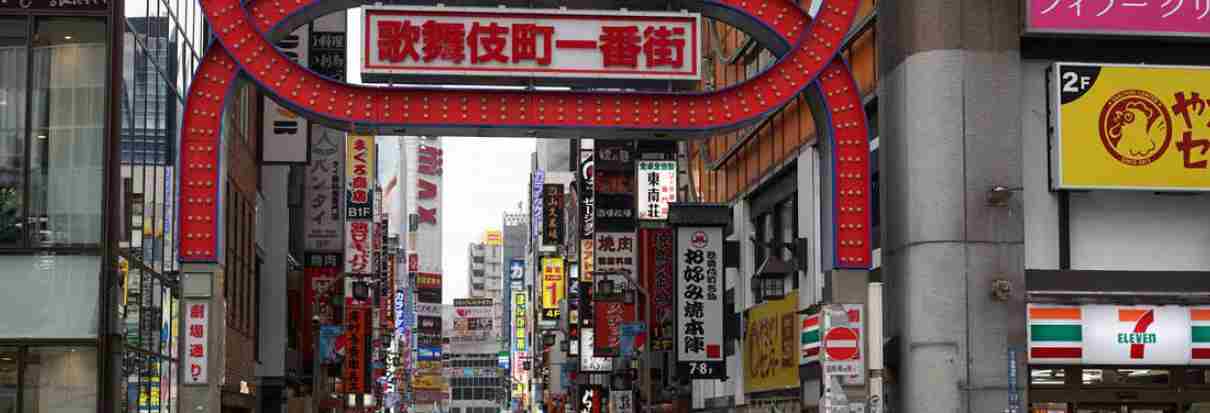
▲ Kabukichō Ichibangai is an iconic symbol of the most (in)famous bar district in Japan.
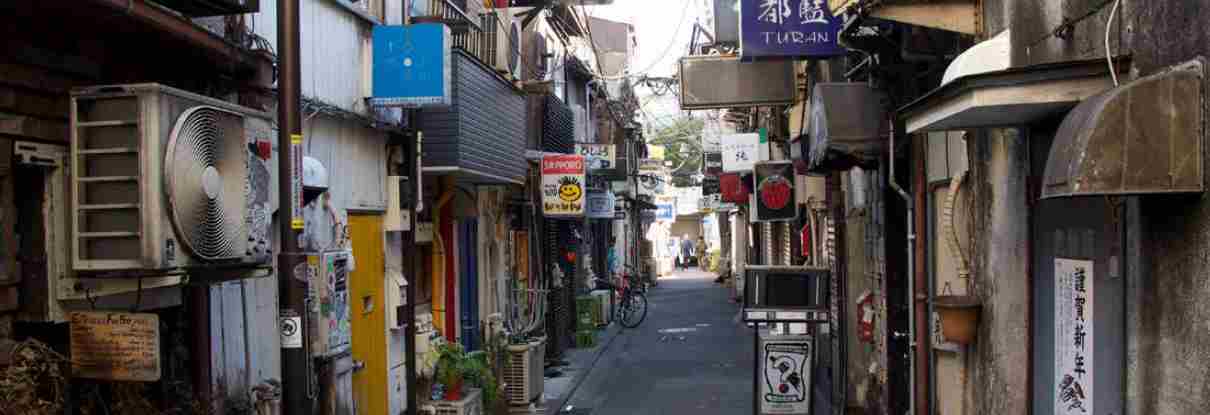
▲ The small and cozy bars of Golden Gai are old, worn, and lovely in their own ways.
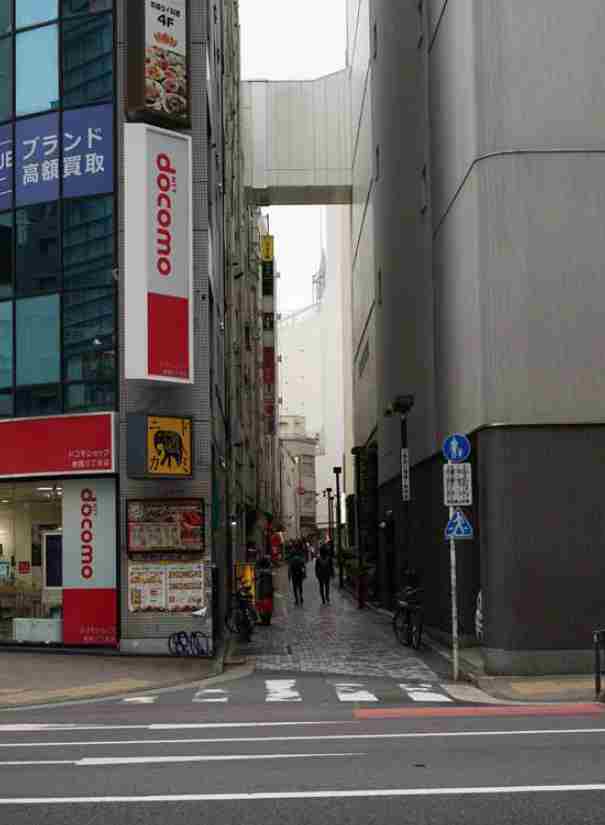
▲ This alley is used as a pedestrian walkway with access to small shops.
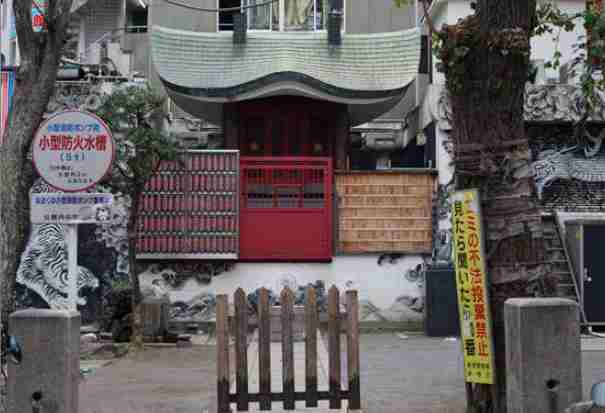
▲ Surrounded by shady businesses, the Kabukichō Benzaiten still is a place of prayer.
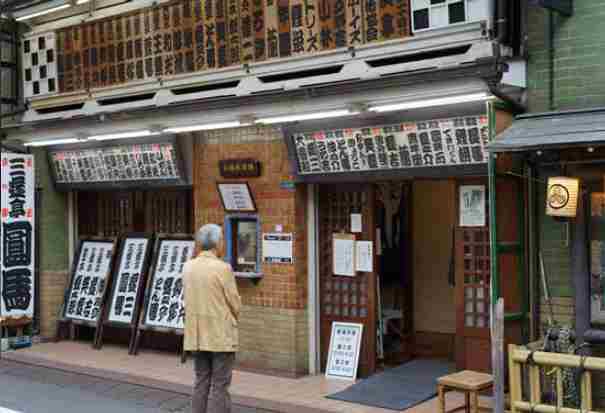
▲ Suehirotei, a classic yose (variety theater), has provided entertainment for generations.
Some 170 tiny bars are packed into a small area here, many with unique themes. Each is on a tiny separate plot, preventing developers from getting their hands on the land as every owner would have to agree to sell. The buildings are two or three stories. In the past the upper stories were residences, and some still are. Many bars have a clearly posted seating charge or are private clubs (a way to make sure regulars have a spot to sit). This area was originally called Hanazono Gai until the new name came into use in 1965. During the day things are very quiet, but it is still worth exploring for the unique exterior decorations. At night things liven up as the bars open, many around 9 p.m. Some of the bars are long established; some are new enterprises with young proprietors who took over from retiring owners. The area has long had a reputation for being popular with artists, writers, journalists, movie directors, and other artistic types. Each spring and fall there is a flea market. The dates float, but you may stumble on it when you visit.
The original Old Boy manga has many scenes that take place in a bar here—alas, the bar Moon Dog was fictional. The Wim Wenders documentary Tokyo-Ga, which is included on the Criterion release of Late Spring, has some scenes shot in the bar La Jetée.
This is one of the older shrines in this area. The present buildings date from 1965, as the shrine burned down in World War II. The origin of the shrine goes back to well before the Edo period—it is said that Yamato Takeru founded it in the 1st century. In the 17th century the shrine was moved from where the Isetan department store is now to a garden belonging to a branch of the Tokugawa family. This explains the name, as hanazono means “flower garden.”
To the right on the way to the main hall is a row of small red torii. These mark the path to Itoku Inari Daimyōjin. If you choose to walk down that row, be sure to duck if you are tall. Toward the end of the path look up and you will see a large wooden penis mounted on the last torii behind the carved sign. Couples pray at this small shrine for marital happiness and children.
In the northeast corner of the grounds you will find Geinō Asama Jinja. Since the Edo period, performers have prayed here for success in the arts and in hopes of improving their talents. The writing on the wall is the names of entertainers who have prayed here.
Close to the right of the main shrine building is Osame Daimyōjin. This is where old talismans and charms are gotten rid of. This small shrine is also popular for people praying to get rid of anything that angers them.
While the main entrance is on the east side, you can also approach the shrine from the west or south.
On Sundays a flea market is held here. The shrine festival is held on the Saturday, Sunday, and Monday closest to May 28.
Even though Inari shrines are not usually associated with Tori no Ichi, Hanazono Jinja is known for its celebration of this particular festival each November, complete with a sideshow.
DETAIL 7
A four-story kōban is rare—they usually are two stories or fewer. Given that Kabukichō does occasionally get out of hand, it makes sense to have a larger facility here, and the kōban is a busy one. The building is rather nice and distinct enough to stand out from the rest of the neighborhood, a good feature in a kōban.
There are usually English-speaking staff available here; it was one of the first kōban in Tokyo to provide this on a regular basis.
 Love Hotel district 歌舞伎町のラブホテル街
Love Hotel district 歌舞伎町のラブホテル街
Located in the north end of Kabukichō, this area has a mix of commercial hotels and love hotels. I have known people who booked hotel rooms in this area and were shocked (or delighted) at the “other” hotels in the vicinity and at having to walk through Tokyo’s most (in)famous bar district to get to their accommodations. There are also bars, host clubs, and restaurants mixed in with the hotels. The architecture is rather creative and varied. If you like unusual architecture, this is an area for a stroll with your camera.
This is what is called a zakkyobiru, an often-narrow building with multiple shops housed in a single vertical structure. These are seen all over Tokyo, and in this neighborhood most have little to distinguish them other than their brightly lit signage at night. Even during the day, the Ichibankan stands out in its mixed-use neighborhood on the edge of the love hotel district with its unique shape and striped exterior. It was built in 1969 and designed by Takeyama Minoru.
SHINJUKU STATION DETAIL 7
A local Inari shrine with a history going back to 1653. There is a small shrine to Ebisu on the grounds that is on the local Shichifukujin tour—it is to the left of the office building. To the right of the office building is an Asama shrine on a small fujizuka. The fujizuka used to be larger but was reduced when the shrine was renovated.
At the entrance, to the right of the torii, is a statue of a demon with a large stone water basin called a mizubachi on its head. The story goes that at night the basin made a sound as if water was pouring on it. The owner was disturbed by this and tried to break the basin but failed. After that he had a streak of bad luck and so gave the basin to the shrine. By the way, Kiō (鬼王) in the name of the shrine means oni king, “demon king,” unsual for a shrine name.
People pray at this shrine for relief from skin diseases and other health problems.
The annual festival is on September 18.
 Korea Museum / Kōrai Hakubutsukan 高麗博物館
Korea Museum / Kōrai Hakubutsukan 高麗博物館
Established in 2001 and located on the seventh floor of this building, the museum is devoted to the history of Korean-Japanese relations and ethnic Koreans in Japan. The neighborhood is one of the largest ethnic Korean neighborhoods in Tokyo. Exhibits cover a variety of related topics: the history of diplomacy, art, ethnic discrimination, music, and more. Visitors can also try on traditional Korean clothing for photographs.
 https://kouraihakubutsukan.org
https://kouraihakubutsukan.org
Encounter at Inari Kiō Jinja
The first time I visited this shrine was on a January 2. As I waited outside the shrine grounds for my friend to finish taking pictures, I spotted an elderly man in kimono walking down the street accompanied by three tough-looking men in suits. One can never tell when one will spot a yakuza boss making a New Year visit in this part of Tokyo.
DETAIL 8
A Jōdoshū Buddhist temple with an entrance on the broad Yasukuni Dōri. Jōkakuji looks pretty ordinary; however, as you walk between the temple gate and main hall you will see three interesting items on the left. The first is the Asahi Jizō, a memorial to nine couples who committed love suicide. Next is a monument marked Shiraitozuka, which is related to a kabuki play about the romance between the prostitute Shiraito and her customer Suzuki Mondo. The largest is a mass grave that was established in 1860 for prostitutes who had no one to claim their bodies. Over 2,000 are buried here. There is a similar mass grave in Tokyo, at Jōkanji, which is mentioned in the Yoshiwara and Sanya chapter. Elsewhere on the grounds there is the grave of Harumachi Koikawa, who played a crucial role in creating the highly popular Kibyōshi genre of satirical illustrated literature in the Edo period. When he got into trouble with the authorities during a moralistic crackdown, he passed away before they could question him.
A Jōdoshū Buddhist temple founded in 1594. Here you can see a statue of the Datsueba, the old hag who strips the dead of their clothes before they cross the river into the afterlife. People have traditionally prayed to Datsueba here to stop a cough; the statue has the nickname of wata no obaba “cotton grandmother.” Since 1957, each February 8 a hari kuyō “memorial service for broken needles” has been held. There is a harizuka “needle mound” where they are buried.
Tokyo’s most famous (but not only) gay bar district. During the day this area looks rather sedate, until the bars open at night. The compact neighborhood consists mainly of small bars, cafes, and other businesses. Most bars in the area have a specialty depending the taste of the clientele: bars for those who like older guys, chubby guys, and so on. There are also many places for lesbians, and bars where straight and gay patrons can mix. Before the anti-prostitution law came into effect in 1958, this area had been a brothel district. Like Kabukichō, this neighborhood became a bar district. The history of gay hangouts in East Shinjuku goes back to the immediate postwar period with places like Yakyoku, one of Mishima Yukio’s hangouts. By the way, the term “gay bar” was apparently introduced into Japan by American soldiers in the 1950s.
SHINJUKU STATION DETAIL 8
Originally this was a thatched hut residence established in 1596 by the monk Taisō. Later it became a temple for the Naito daimyō family. There are interesting statues here. The statue of Enma, the judge of the dead, dates from 1814; however, the body was severely damaged in the Great Kantō Earthquake and replaced in 1933. The other main statue is of Datsueba, the old hag mentioned in the entry for Shōjuin above. There is a button you can push to turn on a light to get a better view of the statues. There is also a statue of Hotei that is on the Shichifukujin tour in one of the buildings. The grounds have a famous bronze seated Jizō, one of the Edo Roku Jizō from the 18th century. The architecture here is a mix of new and old, with the statues mentioned above in a traditional building.
The entrance is on the south side.
 Shinjuku Gyoen National Garden / Shinjuku Gyoen 新宿御苑
Shinjuku Gyoen National Garden / Shinjuku Gyoen 新宿御苑
This very large garden covers 58 hectares (143 acres) and contains wooded areas, ponds, and numerous structures. Originally this was the location of the daimyō mansion of the Naitō clan. In 1872 it was turned over to the imperial household and used for agricultural experiments. In 1906 the garden was done over in the style of a European park. In 1949 it became a public park with sections devoted to English, French, and Japanese styles. The garden is known for its roses, cherry blossoms in the spring, and chrysanthemums and autumn foliage in the fall. Each November from the first to the fifteenth, there is an exhibit of chrysanthemums grown by the gardeners. A small admission fee is required for entry and is very much worth it.
The 2013 film Garden of Words, directed by Shinkai Makoto, is largely set here.
 https://www.env.go.jp/garden/shinjukugyoen/english/index.html
https://www.env.go.jp/garden/shinjukugyoen/english/index.html
DETAIL 9
Built in 1228, this was the guardian shrine of Higashi Okubo village. Sugawara no Michizane is the main kami enshrined here. The name of the shrine comes from the direction the main hall faces: Nishimuki means “facing west.” The buildings are older wooden structures approached by a stairway leading up to the crest of the slope. There is a fujizuka on the grounds.
Senpukuji was founded in 1631. The current temple is a plain-white modern concrete structure. Even the gate is modern, being made of wrought iron. Those interested in Japanese art may want to pay respect at the grave of the famous late Edo and Meiji period ukiyo-e print designer Yoshitoshi.
SHINJUKU STATION DETAIL 9
